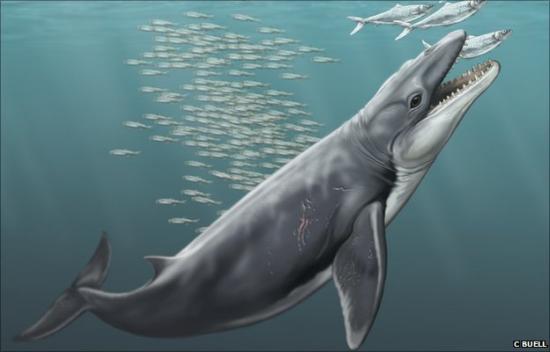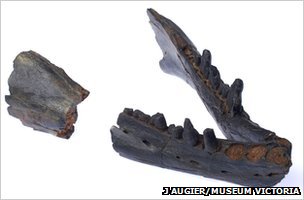远古鲸化石提供了滤食鲸巨大嘴巴的进化证据。

远古鲸可能取食大型鱼类和乌贼
现代须鲸(如蓝鲸)能从大量海水中过滤小型海洋生物。
松弛的下颌骨让它们能张开巨大的滤食嘴巴。
对远古颌骨的研究表明,自然界进化的最大的嘴巴可能用于吸食大猎物,而不是摄取小型的浮游动物。
研究人员在Biology Letters 期刊上发表了相关研究,他们指出史前的下巴与现代须鲸的完全不同。
现代鲸中,下颌骨接在特殊的颌关节上,而颌关节支持两侧颌骨的转动。

业余收藏家的化石
通过2个弯曲的下颌骨,须鲸能够张开巨大的嘴巴用于吞食大量的水和猎物。
墨尔本维多利亚博物馆的研究负责人Erich Fitzgerald 称,令人信服的证据表明现代须鲸具有远古须鲸没有的转动下巴,它能够让现代须鲸吞入大量的海水,进而滤食虾和其它小动物。
化石鲸 Janjucetus hunderi 具有很宽的上颌,Fitzgerald 博士称,加宽的上颌骨是大嘴巴鲸进化的最早一步。
从进化树中得到一些进化证据,如蓝鲸由Janjucetus hunderi 进化而来。
他说,我们能够在远古鲸到现代鲸之间发现颌骨进化的顺序。(生物探索译 Pobee)
生物探索推荐英文原文
An ancient whale fossil has shown a key step in the evolution of
filter-feeding whales' enormous mouths
Modern baleen whales, such as blue whales, can filter small marine creatures from huge volumes of water.
Their "loose" lower jaw joints enable them to produce a vast filter-feeding gape.
A study of this ancient jawbone showed that nature's largest mouths probably evolved to suck in large prey rather than to engulf plankton-filled water.
The researchers, from Australia and the US, reported their findings in the Royal Society journal, Biology Letters. The prehistoric jaw, they noted, was very different from modern baleen whales.
In modern whales, the lower jaw does not fuse at the "chin". Instead there is a specialised jaw joint that allows each side of the jaw to rotate.
By having two curved lower jaw bones that rotate in this way, baleen whales are able to produce huge gapes to take in massive quantities of water and prey.
Lead researcher, Erich Fitzgerald from the Museum Victoria in Melbourne, said: "This is compelling evidence that these archaic baleen whales could not expand and rotate their lower jaws, which enables living baleen whales to engulf and expel huge volumes of seawater when filter feeding on krill and other tiny animals."
Crucially though, the fossilised whale, named Janjucetus hunderi, did have a very wide upper jaw. Dr Fitzgerald says that this widening was the earliest step in the evolution of today's whales' gigantic mouths.
He charted the anatomical features of whales on an "evolutionary tree" - from Janjucetus hunderi to the blue whale.
"I was able to discover the sequence of jaw evolution from the earliest whales to the modern giants of the sea," he said.
This chart indicated that "the first step towards the huge mouths of baleen whales may have been increasing the width of the upper jaw [to] suck fish and squid into the mouth one-at-a-time.
"The loose lower jaw joint that enables living baleen whales to greatly expand their mouths when filter feeding evolved later."
This particular whale was so primitive that it had not evolved its comb-like baleen; it had "ordinary" teeth.
Its fossilised jawbone was discovered in the 1970s by an amateur collector in a coastal town in Victoria, south-east Australia.
"I first saw [it] while visiting a private collection in 2008," recalled Dr Fitzgerland. "I immediately recognised the characteristic shape of the lower jaws of a whale."
Jeremy Goldbogen, a researcher from the Cascadia Research Collective in Washington, who studies the feeding strategies of modern whales, said that bulk filter feeding was "one of the most fascinating adaptions in the animal kingdom".
He told BBC Nature: "An important point to note is that bulk filter feeding using [rotating jawbones] does not necessarily mean that suction is not used.
"A prime example of this are grey whales which are notorious suction filter feeders." Fossil shows huge mouth evolution







